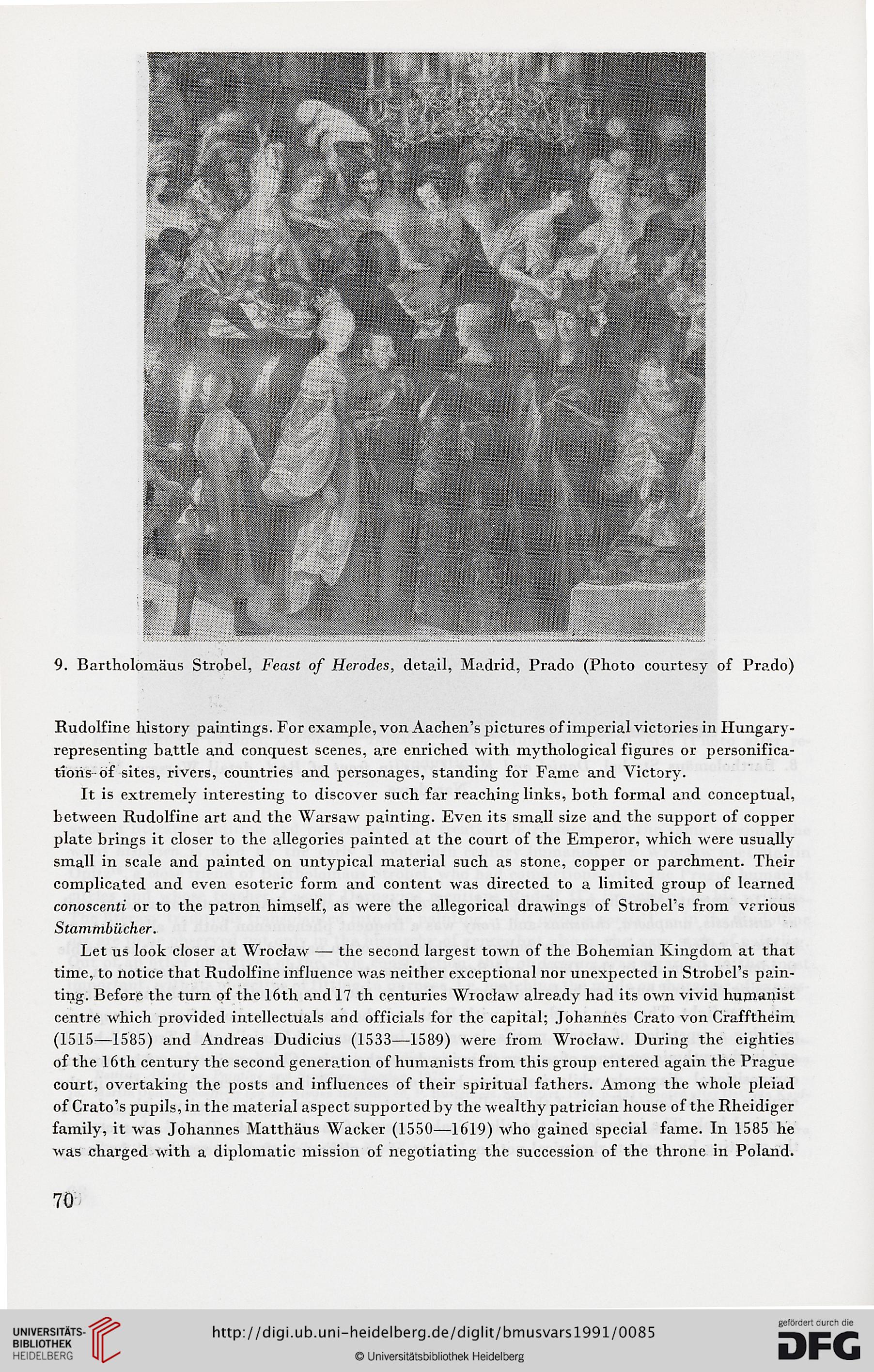9. Bartholomaus Strobel, Feast of Herodes, detail, Madrid, Prado (Photo courtesy of Prado)
Rudolfine history paintings. For example, von Aachen's pictures of imperial victories in Hungary-
representing battle and concjuest scenes, are enriched with mythological figures or personifica-
tioris óf sites, rivers, countries and personages, standing for Fame and Victory.
It is extremely interesting to discover such far reaching links, both formal and conceptual,
between Rudolfine art and the Warsaw painting. Even its smali size and the support of copper
plate brings it closer to the allegories painted at the court of the Emperor, which were usually
smali in scalę and painted on untypical materiał such as stone, copper or parchment. Their
complicated and even esoteric form and content was directed to a limited group of learned
conoscenti or to the patron himself, as were the allegorical drawings of StrobePs from vrrious
Stammbucher.
Let us look closer at Wrocław — the second largest town of the Bohemian Kingdom at that
time, to notice that Rudolfine influence was neither exceptional nor unexpected in Strobel's pain-
ting. Before the turn of the 16th aiid 17 th centuries Wrocław already had its own vivid humanist
centrę which provided intellectuals and officials for the capital; Johannes Crato von Crafftheim
(1515—1585) and Andreas Dudicius (1533—1589) were from Wrocław. During the eighties
of the 16th century the second generation of humanists from this group entered again the Prague
court, overtaking the posts and influences of their spiritual fathers. Among the whole pleiad
of Crato's pupils, in the materiał aspect supported by the wealthy patrician house of the Rheidiger
family, it was Johannes Matthaus Wacker (1550—1619) who gained special fame. In 1585 he
was charged with a diplomatic mission of negotiating the succession of the throne in Poland.
70
Rudolfine history paintings. For example, von Aachen's pictures of imperial victories in Hungary-
representing battle and concjuest scenes, are enriched with mythological figures or personifica-
tioris óf sites, rivers, countries and personages, standing for Fame and Victory.
It is extremely interesting to discover such far reaching links, both formal and conceptual,
between Rudolfine art and the Warsaw painting. Even its smali size and the support of copper
plate brings it closer to the allegories painted at the court of the Emperor, which were usually
smali in scalę and painted on untypical materiał such as stone, copper or parchment. Their
complicated and even esoteric form and content was directed to a limited group of learned
conoscenti or to the patron himself, as were the allegorical drawings of StrobePs from vrrious
Stammbucher.
Let us look closer at Wrocław — the second largest town of the Bohemian Kingdom at that
time, to notice that Rudolfine influence was neither exceptional nor unexpected in Strobel's pain-
ting. Before the turn of the 16th aiid 17 th centuries Wrocław already had its own vivid humanist
centrę which provided intellectuals and officials for the capital; Johannes Crato von Crafftheim
(1515—1585) and Andreas Dudicius (1533—1589) were from Wrocław. During the eighties
of the 16th century the second generation of humanists from this group entered again the Prague
court, overtaking the posts and influences of their spiritual fathers. Among the whole pleiad
of Crato's pupils, in the materiał aspect supported by the wealthy patrician house of the Rheidiger
family, it was Johannes Matthaus Wacker (1550—1619) who gained special fame. In 1585 he
was charged with a diplomatic mission of negotiating the succession of the throne in Poland.
70




